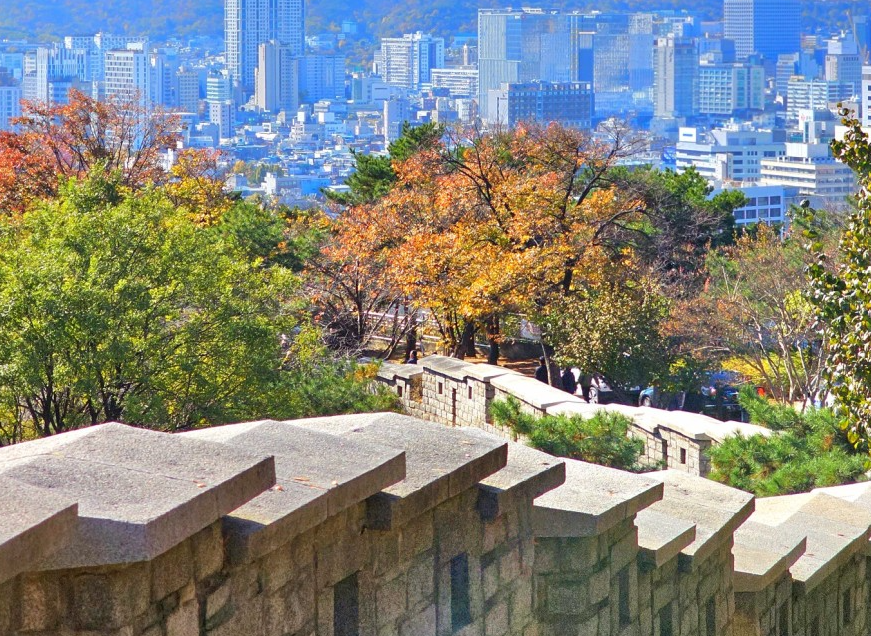Naksan Park and Seoul Fortress Wall is a good walking path along the old Joseon Dynasty’s Hanyangdoseong Road (Seoul Fortress Road) in the heart of downtown Seoul, which is full of high-rise buildings and beautiful cityscapes, and many people come here to exercise. The Seoul Fortress Trail course is broken into numerous sections, the most well-known and easily accessible from the city center being the Naksan section route, which begins near Hyehwamun and continues into Naksan Park and Dongdaemun. So, in this piece, I’d like to introduce you by strolling down the Naksan section of Seoul Fortress Road.
The Seoul Fortress Road Naksan Course begins at Hyehwamun, runs through Naksan Park and Ewha Village, and ends in Dongdaemun (Heunginjimun). Hyehwamun is easily accessible by taking the subway line 4 to Hansung University Station and exiting at 4. Hyehwamun’s former name was Honghwamun, and if you’re interested in Joseon Dynasty palaces, you’ve most likely heard of it. Honghwamun is the main gate to Changgyeonggung Palace, which is located just across from Seoul National University Hospital.

The Seoul Fortress Trail track starts at the entrance to a little lane across Hyehwamun Street. It is easy to find because there are signs. If you climb the stairs slightly, you will be able to see the outer wall of the city wall and begin walking the Seoul Fortress Trail route in earnest. The Naksan segment of the Seoul Fortress Trail is a popular course because it involves walking along the outer wall of the city wall, which is in pretty good condition. And there is a slight elevation difference, so after hiking a few hills, you may enjoy a refreshing view of downtown Seoul below.

There are well-marked signs indicating the current location along the wall, so anyone can easily walk without getting lost. If you walk along the wall road from Hyehwamun Gate, you can see a sign for Jangsu Village, where old houses are gathered together. A sign for an old, rural village in the middle of downtown Seoul… it seemed somewhat unexpected. Walking along the fortress wall in Naksan Park allows you to experience Seoul’s wonderful city center and old architecture.

After passing through Jangsu Village, you’ll come to a relatively steep uphill road. Consider it the steepest road among the Naksan region courses. Once you reach this point, there are no more challenging sections to climb, so you may take your time. The views below appears clearer as the height increases. If you come up in the evening, I believe the night view of Seoul from up here will be breathtaking.

After hiking nearly all the way uphill, you’ll come to a little rock gate that leads to the inside of the city wall. After you pass past this rock gate, the route leads straight to Naksan Park.
In my situation, I traveled to Naksan Park via the fortress road from Hyehwamun. If you wish to go directly to Naksan Park without passing through the fortress road, exit Hyehwa Station at Exit 2, pass Horse Chestnut Park, and continue up toward Naksan Park. The view of Seoul from Naksan Park was also really stunning. I could also see the Namsan N Tower in the distance. Ihwa Mural Village is located beside Naksan Park. It is believed that there were a lot of people visiting this location when the mural village was at its peak popularity, but it currently appears to be a little quieter, possibly due to less tourists.
If you walk past Naksan Park and Ihwa-dong Mural Village and continue down the castle road, you’ll arrive at Heunginjimun, the end of the Naksan section course. The Hanyangdoseong Museum can be found along the way down. From here, the fortress road leads past Dongdaemun Digital Plaza and towards Namsan. Unfortunately, development has left no remnants of the city walls in this part. Anyway, the path from Hyehwamun to Heunginjimun is the piece of the fortress wall that remains intact, so if you wish to walk along it, I recommend the Naksan Park area.

